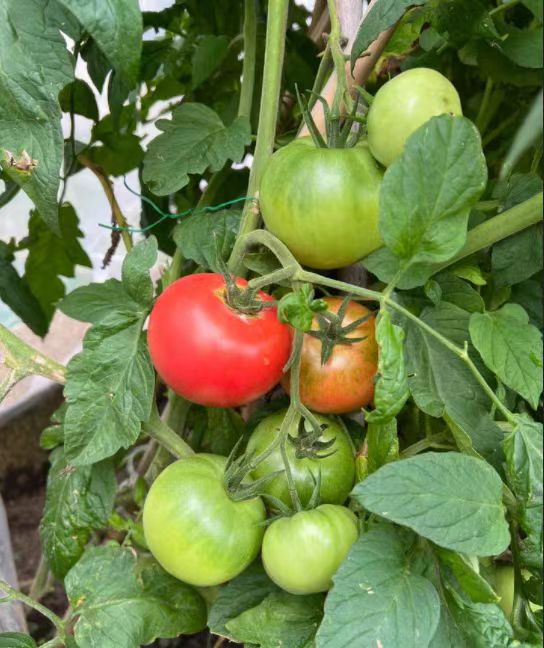Staking is a crucial step when growing tomatoes in a courtyard! Why is that? Because tomato stems are naturally soft, especially indeterminate varieties that keep growing vertically. As the plant grows taller, the stem becomes thinner. Without staking, the heavy fruit will easily bend or break the stem after flowering and fruiting, causing the entire plant to collapse to the ground.
Moreover, after staking, tomato branches and leaves can spread out without crowding, improving air circulation and allowing more sunlight to reach every leaf. This not only reduces diseases like gray mold and leaf mold but also helps tomato fruits accumulate more nutrients, making them sweeter and more flavorful. Additionally, a well - set stake makes it much more convenient for daily tasks such as watering, fertilizing, and pruning. With the fruits hanging in the air and not touching the ground, the chance of being damaged by germs and pests in the soil is reduced, and naturally, there will be fewer rotten fruits.
Prepare materials before staking. Bamboo poles and wooden sticks are the most commonly used. Use 2 - 3 - meter poles for indeterminate varieties and 1.5 - 2 - meter poles for determinate varieties. Bamboo poles are tough, and for wooden sticks, choose non - perishable ones like pine. In windy areas, steel pipes can be used, which are more sturdy but cost more. In small spaces, nylon ropes can be used for vine suspension, with horizontal poles fixing the ropes to let the plants climb. Tools needed include a tape measure, scissors, binding tape, and a hammer.
The best time to stake is when the seedlings grow to 30 - 40 centimeters tall after (transplanting). At this time, the root system is stable and the stem is firm, making it less likely to be injured. Staking too early may cause the tender seedlings to break, while staking too late may result in the plant having already fallen or bent, making adjustment troublesome.
Choose different staking methods according to different situations. Use the single - stem stake method for small spaces or determinate varieties: insert a pole next to each plant and tie the stem loosely with binding tape every 20 - 30 centimeters to leave growth space. In rainy and windy areas, use the herringbone stake method: insert two poles obliquely to form a "herringbone" shape, tie the tops tightly, add a horizontal pole in the middle and upper part, and bind the stem to the horizontal pole for strong stability. For large varieties or those with many fruits, use the triangular/quadrangular stake method: insert several poles obliquely to form a corner shape, tie the tops firmly, bind horizontal poles at different heights, and fix the plant evenly for strong support. Use the fence stake or (trellis) method for large - area planting or landscaping: for the fence stake, set up vertical columns on both sides of the planting row and pull wires; for the trellis, build a frame above the courtyard to let the plants climb onto the frame, with the fruits hanging below and also providing shade.
When staking, insert the pole 30 - 40 centimeters into the soil. In loose soil, pile soil or use stones to fix it to prevent shaking. Use the "8" - shaped method to bind the vines, loose around the stem, and bind once every 2 - 3 leaves, binding as the plant grows. Regularly check the stake and reinforce it in time if it is skewed. When the indeterminate variety grows to the top of the stake, you can pinch the tip to promote side branches or add an extension pole. At the same time, prune side branches and yellow leaves. For indeterminate varieties, leave the main stem, and for determinate varieties, leave strong side branches to increase fruit production and ventilation.
After staking, do not relax management. Water slowly along the roots to prevent soil erosion and pole loosening. Fertilize in stages, applying nitrogen fertilizer in the seedling stage to promote growth and phosphorus and potassium fertilizer during the flowering and fruiting stage to strengthen the fruits. Although there are few diseases, check regularly and use biological, physical, or chemical methods to control pests and diseases in time. When the fruits are expanding, use a mesh bag to support the branches with many fruits to prevent breaking, and remove diseased and deformed fruits to concentrate nutrients.
As long as you choose the right stake according to the environment and variety, set it up and manage it well, the courtyard tomatoes will surely grow vigorously and bear numerous fruits, allowing you to enjoy the joy of planting and harvesting!
Do tomatoes need to be staked when planted in a courtyard?

Share with
Tagged in :




Leave a Reply